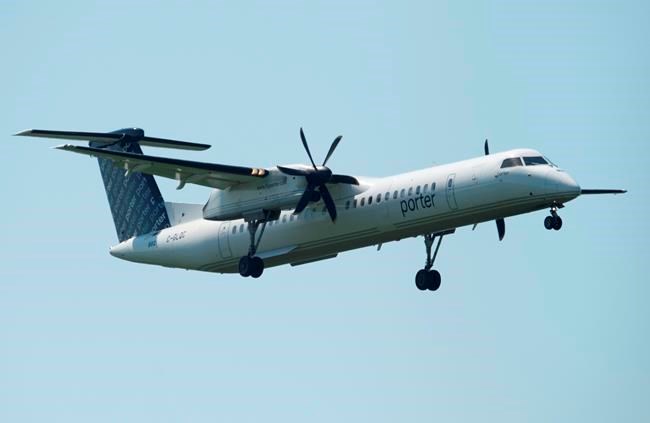Porter Airlines CEO Michael Deluce says the travel market is too small to keep all of sa╣·╝╩┤½├Į's airlines afloat for two more years, even as several embark on swift expansion plans — Porter most of all.
His comments come the same day the company announced a partnership deal with Alaska Airlines — 15 days after unveiling a different one with Air Transat — as the former regional carrier looks to round out its rapid growth across the continent.
As well as partnering with other carriers, the Toronto-based airline aims to grow its fleet to 79 planes by 2025, two-thirds of them jets. That's up from 29 turboprops last year.
It's also taken on 300 pilots over the past year — "an enormous amount of hiring" — to fly the 25 new Embraer narrow-bodies that have descended on its hangars since Jan. 1, Deluce said.
But as domestic airlines spread their wings, they risk elbowing each other out, especially newer ultra-low-cost carriers (ULCCs).
"I don't believe that the traction's there for the multitude of ULCCs that are in the market," Deluce said in an interview.
By the end of next year, Flair Airlines also aims to increase its fleet to 26 planes from 21, and Lynx Air to 17 aircraft from its current nine. They both hope to hit 50 over the next two to three years. Meanwhile, sa╣·╝╩┤½├Į Jetlines plans to have 15 aircraft in the next 13 months. It currently has three planes.
"I would say not all of those plans will come to fruition," Deluce said, though he avoided singling any company out.
WestJet has already shut down budget subsidiary Swoop, folding it into its mainline operation in October. It plans to do the same with Sunwing Airlines, which it acquired in May.
As competition ramps up, ticket prices are plummeting. Fares fell 19 per cent in October compared with the same month a year earlier, according to Statistics sa╣·╝╩┤½├Į.
The figure follows a roughly 21 per cent year-over-year drop in September and a 20 per cent decrease in August, as capacity grows even while consumers think twice about travelling in a world of higher costs.
The increasingly crowded airspace also comes amid a continued lag in business travel — a key market for non-budget airlines thanks to its higher yields.
Porter is relying on lower operating costs for its smaller Embraer E195-E2 aircraft than those borne by the bigger planes it competes against, such as the Boeing 737 Max and Airbus A320.
"It allows you to take less risk in entering new markets, with less seats to fill. As well, you can offer more frequency, which is important to customers," Deluce said.
"You can enter mid-sized markets with daily service that a larger 190- or 200-seat aircraft could not."
The carrier is also banking on a premium customer experience that includes free Wi-Fi, complementary snacks, wine and beer and no middle seat.
"Economy air travel or not, one thing is certain: No one likes a middle seat."
On Wednesday, Porter announced a partnership with Alaska Airlines that allows travellers to buy combined Porter-Alaska itineraries directly from Porter's website or via third-party agencies.
The interline agreement opens up access to 18 western U.S. cities via Alaska hubs in Los Angeles and San Francisco to passengers in Porter's home base of Eastern sa╣·╝╩┤½├Į, the airlines said. It also widens the gate to a large part of sa╣·╝╩┤½├Į for Americans west of the Mississippi River.
Porter flights from Toronto to California are expected to start in January, and connections via shared Canadian airports are planned for early 2024, the carriers said.
Alaska's loyalty plan members will start earning points on Porter flights booked via Alaska Airlines starting in January. Both VIPorter and Alaska Mileage Plan members will earn miles in their respective points programs no matter where they book their flights beginning later next year.
The deal comes barely two weeks after Porter and Air Transat announced a "joint venture" — though finances will remain separate — to expand their range of destinations, tap into each other's markets and gear up for a battle with the country's biggest carrier, Air sa╣·╝╩┤½├Į.
For Porter, that deal will unlock the door to Europe and the sunny southern getaways currently being served by Air Transat. Meanwhile, Montreal-based Air Transat, which largely operates tour package trips, can benefit from access to Porter's growing network in sa╣·╝╩┤½├Į and the United States.
Jacques Roy, a professor of transport management at HEC Montreal business school, said many North American markets are nearly saturated. There's more room for expansion on transatlantic flights and trips to Asia.
“Most of the growth that we see is coming from international flights and destinations. I don’t see a major breakthrough in the number of passengers inside of sa╣·╝╩┤½├Į,” he said.
Porter recently said it had placed a firm order for 25 more Embraer jets, with a list price of US$2.1 billion. It had previously ordered 50 of the E195-E2 narrow-bodies, with half of those already in its hands.
The airline has purchase rights on 25 more of the 132-seat planes, which would give it 100 jets in total by 2027, making it by far the biggest domestic Air sa╣·╝╩┤½├Į rival east of the Prairies.
This report by The Canadian Press was first published Dec. 13, 2023.
(Companies in this story: TSX:TRZ, TSX:AC)
Christopher Reynolds, The Canadian Press



